|
| TWO BALL: Arrange the class with partners
about 6-8 feet apart . Scatter as many tennis balls/wiffleballs in the gym area. On a signal the partners must go to as many
different balls in a 30 second time limit. After two catches they move to the next ball. Chose different types of throw each
time and try to beat the previous score(rollers, one bounce , no bounce) |
|
| TWO BALL ALTERNATIVE: Arrange the
class into each side of the midcourt area in a scattered formation. Use 2-4 wifffleballs on each side. The object is to have
the opposite team "stuck" with more wiffleballs. The game starts with a thrower who must toss it to another person on their
team.That person then throws to another person(2 throws). The second catch person then rolls the ball to the other side of
the midcourt line . After a certain time limit -count the balls on each side. |
|
| TWO BASE: Divide the class
into groups of four with two poly spot bases and two traffic cones. The ply spots should be about 20-30 feet apart and the
cones about 15-20 feet apart. Start a runner at each poly spot and thowers at each cone. The throwers will toss back and forth
and runners back and forth. After the time limit , compare the tosses with the running bases and try to beat what the other
group did . Repeat for a better score. |
|
| WALL BALL: Arrange the teams between traffic
cones(3) that are placed about 8 feet apart. The first cone should be about 4-5 feet away from the wall . There will be two
players on offense who will bounce the ball off the floor and then rebound against the wall . After a toss the next player
has a turn. The players in the field will try to catch the ball before it hits the floor and when there are 3 outs , switch
teams and repeat the process . Here are some ideas for more play and less arguements: |
|
| 1. Any ball outside the cones is an out. |
|
| 2. Any ball that doesn't pass the first cone is
an out. |
|
| 3. A ball hitting the wall first is an out. |
|
| 4. Make 7-8 courts for more action . |
|
| 5. Switch teams after 3-4 minutes |
|
| 6. Next thrower should wait between the cones |
|
| 7. Any interference is a replay |
|
| NELLIE BALL: Use the same alignment but this
time use a bigger ball like a volleyball/playball. Throw it above a designated line(8 feet on wall) and another player must
catch it before it hits the floor. The ball must be thrown from where it is caught and may be thrown to a partner who may
be closer to the wall. Points are scored with every ball on the floor or when a partner drops the ball from a teammate. As
before make 7-8 courts , usually , this means that there will be four courts facinfgeast-west or north -south . Practice which
ball best suits each class . The smaller the ball the harder it will be or the harder the ball , too. |
|
| Divide the class into 6-8 different areas in the following
set-up: Place two bases about 25-30 feet apart. Next , and parallel to the bases are two cones about 15-20 feet apart . Arrange
two players to throw the ball back and forth next to the cones. Place one runner to traverse the bases for 30 seconds. Count
the number of throws and the number of runs to the bases . After the 30 seconds switch partners and try to beat the throws
and runs each time. Repeat the process to improve on the previous score. |
|
| Arrange the class into 2-3 courts with traffic cones
dividing the games . Place two bases on each court -home and second . Put a hula hoop about 6-8 feet away from home and in
foul ground. A catcher must stand in the hoop at all times. The players are arranged in positions on each court with 4-5 batters
waitindg in a designated safe/dugout area. A batting tee may be used in some classes instead of the pitched ball(one or no
bounce). After the ball is hit , the runner runs to second base first . The next batter does the same but the runner on second
must come home. At any time the runners will go to the next base at their peril. When the ball is fielded , it must be thrown
to second or home. If they are caught between the base(es) then it is an out . The catcher must stay in the hoop and an errant
throw must be made by another player . Switch after 3 minutes and repeat the process . |
|
| Place tumbling mats at the origonal base positions. After
the ball is hit , kicked , punched or from a stationary tee , the runner may run to any base as all the runners can BUT all
bases must be touched before coming home. There is no limit to the number at each base . Have a pitcher stand in a hula hoop
to receive the ball from the fielders . If a runner is caught in between the bases it can either be an out or return to the
base area they just left. Switch after a few minutes and repaet the process. |
|
| Divide the class into two groups separated by the
midcourt line of the b-ball court. Give each team 4-5 wiffleballs or beanbags that either must be sliding on the floor(bean
bag) or rolled(wiffleball). The players are scattered throughout their half court. They must either block the oncoming tosses
or throw the bal/beanbag themselves. They will try to hit the back wall on the opposite side of the floor. Any ball/beanbag
that is scored is out of play and the team with the least amount on their side is deemed the winner . As a variation with
the wiffleballs is to place teammates behind the endline and they will place the balls in a box . The beanbags will easily
stay on the floor . NO player may take the ball from the scoring area - it must be kept there . |
|
| Arrange the class into four parallel lines with
the front line of each team abput 20 feet from their teams backline players. Make a free space or neutral area about 10-12
feet between the teams. Give 2-3 players a soft ball to each front line. They must only roll the ball or a one bounce toss
for a score. The object is to get the ball past the front line and also the backline players for a score from head level.
Place cones at each ends back line for boundries. The front line are blockers and tossers. The back line is a blocker and
toss the ball to their own front line. Back line players may not score. After a few moments have the lines switch from front
to back. |
|
| Arrange the teams in baseball/softball position
with the batting team given the opportunity to use any type of euipment they chose. They may be as follows : Paddle ball ,
racquet ball , wifflebat(stationary tee , too), tennis racquet or hockey stick. No upcoming batter may use the equipment of
the previous batter. The next time at bat they must never use the implement twice during the activity. The fielding team may
only tag the runners as there are no force outs. A ball that is caught in mid-air is also an out. The whole team bats and
then switch places. As a variation have no outs but must freeze at the last position when the ball is received by the pitcher.
|
|
| Divide the areas into three sections with a batting
team placed at each section(three batters from the same team hit similutaneously). Place a hula hoop(different color and the
same color wiffleball for each section.(blue hoop/blue wiffleball). The teams are numbered 1,2,3 with (one's) at bat and (two/three)
in the field at each section. Place traffic cones at designated distances. The batter must run around any number of cones
that he/she thinks they can make safely. The furthest cone is 3 points , then two and then one. If the ball is retreived by
the fielder and thrown to the catcher by the hoop , it is an out if that runner is caught in between the arranged cones. The
catcher must catch the ball , boune it in the hoop once and catch it off the rebound. When the whole team bats , then call
a new number to bat. |
THROW AND CATCH
HITTING

DEFENSIVE STANCE
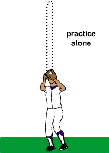
POP UP PRACTICE
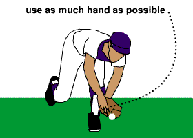
FIELDING
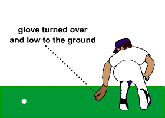
FIELDING BACK HAND

THE GRIP
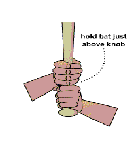
BAT GRIP

LINEAR SWING
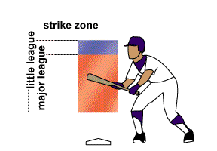
BUNT STANCE
TIPS and DRILLS
( click links above)
THROWING and HITTING TECHNIQUE IN SLIDES !
DIFFERENT
SLIDES FROM THE REAL PLAYER SLIDESHOW 2.0 by STUDENTS in ELEMENTARY SCHOOL AGE:
DEFENSIVE
STANCE
The best way to work on the defensive stance is to practice. Get as much practice on the field as you
can, and work on fielding both high and low balls with a friend. Be sure to get into an athletic, game-like defensive position,
even in practice.
When practicing fielding slow rollers, use as much hand and as little glove
as you can without hurting yourself. The line between using two hands and just your bare hand is a fine one. Save the bare
hand for balls hit slowly enough that you can avoid hurting your hand and can easily field the play. When the ball is traveling
more quickly, use your glove
Practice fielding slow rollers with a partner. Toss slow rollers
back and forth,
and remember to charge the balls and release the throw quickly.
Have a teammate
or coach hit balls to your left and right at ever increasing
distances. Work on getting in front of the ball
so you can avoid using the
backhand. Balls hit at a distance requiring the backhand become that
much
easier, since you gain experience getting close to the ball.
Ground ball backhand
Skills Drills
Distance drill
Have a teammate or coach hit balls to your left and
right at ever increasing
distances. Work on getting in front of the ball so you can avoid using the
backhand.
Balls hit at a distance requiring the backhand become that
much easier, since you gain experience getting
close to the ball.
Position drill
Get
into the actual fielding position for a backhand-knees bent, your dominant side foot slightly in front of your non-dominant
side foot, glove turned over, palm-side down and low to the ground. Have a teammate throw some short hops and field them with
your glove, staying in the backhand fielding position.
Quick grip drill To make great
throws every time, you need to use the right grip. Practice by tossing the ball a few feet in the air. As soon as the ball
hits your glove take it out in the proper grip. Your grip should be the same every time: with your index and middle finger
over the wide part of the seams (the four-seam grip).
Distance drill Play catch with a teammate
to improve your throwing ability. Vary the throwing distances.
Field a pop-up
Practice
solo
Practice! Practice! Practice! You have probably heard it before, but nothing beats practice
when it comes to getting good at catching pop-ups. When you are practicing alone, just toss the ball high into the air. Think
about approaching the ball quickly, catching it smoothly, and making a quick transition to the throw.
Ground
ball jump step
Skills Drills
Hundred foot drill
Practice
the jump step with a partner. Stand 100 feet apart and throw long ground balls to each other. Field the balls and take a jump
step to throw the ball back to your partner.
Stationary drill Try practicing the jump
step simply by running up to a stationary ball, fielding
it and taking a jump step. You do not need to release
the ball to practice the
basic motion.
You can practice the jump step simply by lofting the
ball high into the air, catching it and taking a jump step. You do not need to release the ball to practice the basic motion.
The crow hop
Skills Drills
Distance drill
Practicing
with a friend, stand at gradually increasing distances and throw
grounders back and forth. When you throw,
take a crow hop Just shift your weight
back the same way as you do after fielding a ground ball. IT's just
a little step and hop before you throw the ball .
Standard grip
Skills Drills
Balance
the bat
Practice holding the bat just above the knob with a proper grip and get used to the
length, weight and balance of your bat. A bat you can swing comfortably is better than a heavier bat that will force you to
choke up.
The standard square stance
Skills Drills
Adjustment drill
Start with the basic stance, then adjust it to what
feels most comfortable to
you as you get some experience in the batter's box. Develop a feel for what
works
for you.
Accuracy and timing drill
Practice
getting into the stance over and over again. Focus on accuracy and
timing. When you hear the words "Batter
up!" you want to look smooth, like
a pro.
The linear swing
Skills
Drills
Batting tee
Practicing with a batting tee allows you to break
down the motions. Once you get the feel for the perfect swing, progress to full speed swinging until you are swinging at "game"
bat speed.
Mirror drill Watching yourself in a mirror while you swing
helps. Slow it down to see
each part of the motion. Always concentrate on the mechanics of your
swing...and
stand far back from the mirror!
Pivot stance sacrifice bunt
Skills Drills
Strike
zone
Only bunt pitches in the strike zone.
|

